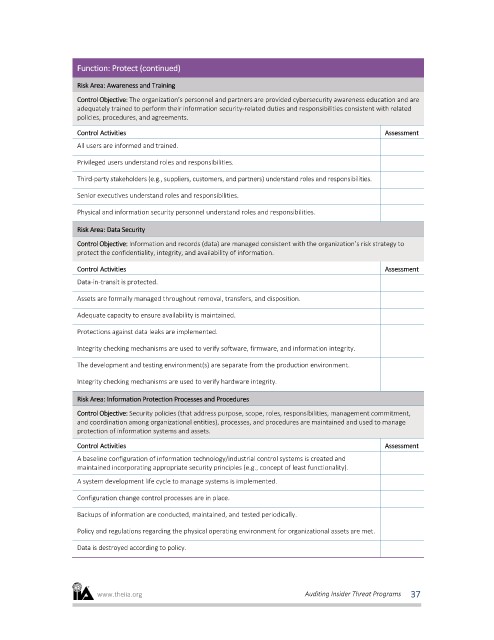Page 405 - ITGC_Audit Guides
P. 405
Function: Protect (continued)
Risk Area: Awareness and Training
Control Objective: The organization’s personnel and partners are provided cybersecurity awareness education and are
adequately trained to perform their information security-related duties and responsibilities consistent with related
policies, procedures, and agreements.
Control Activities Assessment
All users are informed and trained.
Privileged users understand roles and responsibilities.
Third-party stakeholders (e.g., suppliers, customers, and partners) understand roles and responsibilities.
Senior executives understand roles and responsibilities.
Physical and information security personnel understand roles and responsibilities.
Risk Area: Data Security
Control Objective: Information and records (data) are managed consistent with the organization’s risk strategy to
protect the confidentiality, integrity, and availability of information.
Control Activities Assessment
Data-in-transit is protected.
Assets are formally managed throughout removal, transfers, and disposition.
Adequate capacity to ensure availability is maintained.
Protections against data leaks are implemented.
Integrity checking mechanisms are used to verify software, firmware, and information integrity.
The development and testing environment(s) are separate from the production environment.
Integrity checking mechanisms are used to verify hardware integrity.
Risk Area: Information Protection Processes and Procedures
Control Objective: Security policies (that address purpose, scope, roles, responsibilities, management commitment,
and coordination among organizational entities), processes, and procedures are maintained and used to manage
protection of information systems and assets.
Control Activities Assessment
A baseline configuration of information technology/industrial control systems is created and
maintained incorporating appropriate security principles (e.g., concept of least functionality).
A system development life cycle to manage systems is implemented.
Configuration change control processes are in place.
Backups of information are conducted, maintained, and tested periodically.
Policy and regulations regarding the physical operating environment for organizational assets are met.
Data is destroyed according to policy.
www.theiia.org Auditing Insider Threat Programs 37

